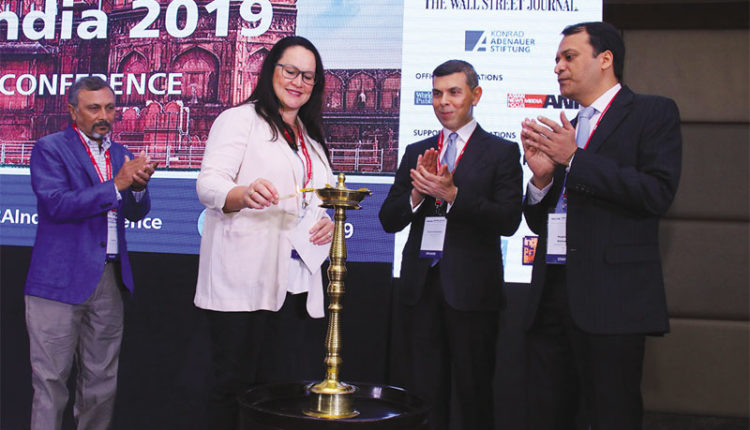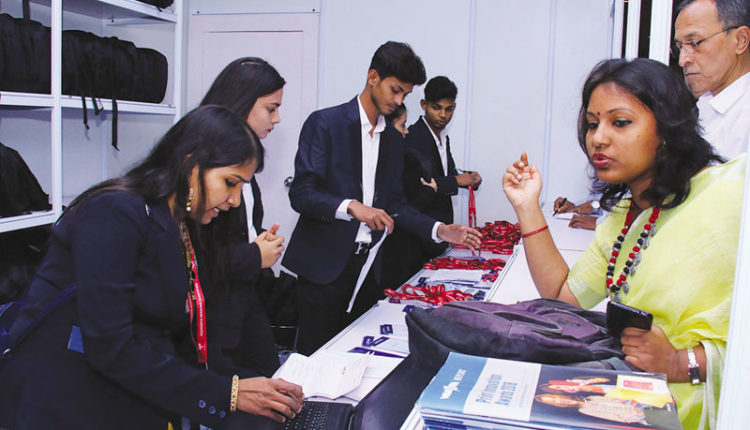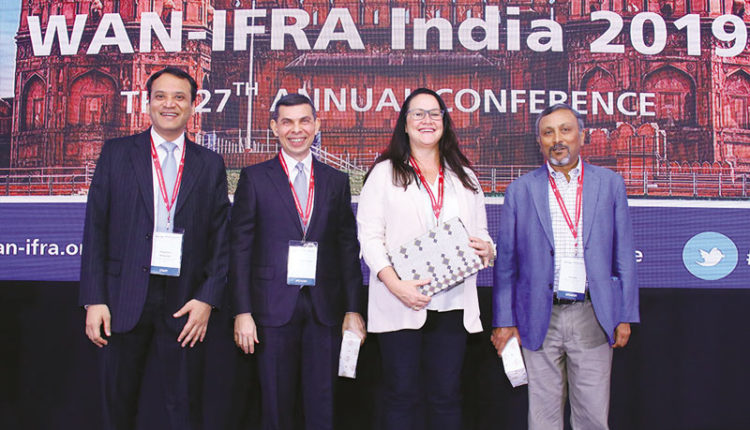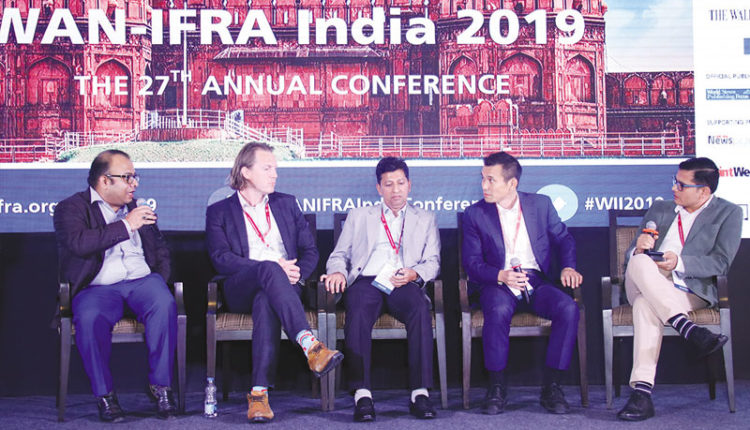Key message from WAN-IFRA India 2019 Conference urges publishers to be their own innovator and disrupter
WAN-IFRA India 2019 Conference, which was held from September 18-19 at Leela Ambience Hotel in Gurugram (Delhi-NCR), gathered publishers discussing driving revenue and excellence in challenging business times. More than 340 news publishing executives from over 25 countries were present at the WAN-IFRA’s 27th Annual Conference in India, co-sponsored by The Indian Newspaper Society (INS).
Discussing and tracing the transformation of the news media business, WAN-IFRA India 2019 Conference had two parallel summits—Advertising Summit for advertising managers and Printing Summit for printing technology managers. The conference was set in motion with three keynote speeches by Lisa MacLeod, Head of Digital at Tiso Blackstar Group, South Africa and Vice President of WAN-IFRA; Warren Fernandez, Editor-in-Chief, The Strait Times & SPH’s English/Malay/Tamil Media Group; and Raj Jain, CEO, Bennett, Coleman & Co Ltd.
 Lisa MacLeod talked about technology innovations and business transformation experiences at Tiso Blackstar Group. “Tiso Blackstar has built its own content management system and has reduced the number of editions. We have trimmed down our print costs. Our reporting staff now starts early in the day to file reports for the web. Paid content is our primary focus and we have six operational paywalls,” she said.
Lisa MacLeod talked about technology innovations and business transformation experiences at Tiso Blackstar Group. “Tiso Blackstar has built its own content management system and has reduced the number of editions. We have trimmed down our print costs. Our reporting staff now starts early in the day to file reports for the web. Paid content is our primary focus and we have six operational paywalls,” she said.
She also mentioned that the data cost for mobile phones are about six times higher than that in Europe and South Africans spend more on communication than on health or education. “To serve this large chunk of our audience who cannot afford data, we have created an app that does not need data to run. SA News LIVE is powered by free content from all our newsrooms,” she added.
Warren Fernandez discussed about extending the life of printed product, while gearing up for a digital-first newsroom and transformation. He said, “We looked at global newsrooms but figured replication was not an option. We needed to understand our audience. We don’t like to call ourselves a digital-first newsroom; print and digital both play an important part for us,” he asserted.
Raj Jain talked about the print business in India and how it is a flag-bearer of responsible journalism. “It doesn’t leave much room for sensationalism and out of context reporting,” he said. Over the last few years while print has fought for survival globally, it has thrived in India. It, however, has also faced challenges. “The habit of reading newspaper in the morning is being threatened by digital notifications and multimedia. Print has to be its own innovator and disrupter in the new world,” added Raj.
The two-day conference was sprinkled with stimulating discussions on newspaper distribution, design thinking, revenue strategies, business transformation and strategic shifts in the Indian advertising landscape.
Changing course in newspaper business
Newspaper Technology History, which is a latest report by WAN-IFRA, documents and analyses the milestone developments in newspaper production, revealing interesting facts which are required for invention of groundbreaking technologies and lessons to change the course of news media business. Balaji Kasturi, Former Director, Kasturi & Sons Ltd (India) and Gerhard Raab, Consultant, Gerhard Raab International Consulting (Germany) were speakers at the session revolving around the innovative developments.
In the session, Emmy D’Silva, Engineering & Newsprint Consultant (India), narrated about the present newsprint scenario, trends in the future and possible price indexes in the pulp & paper industry. He highlighted the current production volume of world’s leading newsprint mills and their supply to India. “Resolute (1829 tonnes), Norske Skog (1759 tonnes), UPM (1585 tonnes)… are some leading newsprint mills in the world with their agents in India such as NTSC and Anika,” mentioned D’Silva. He added that the 45 gsm newsprint, which currently costs $509/tonne, is expected to be $620/tonnes by 2023.
Efficiency & cost optimisation
What does efficiency and excellence mean for a newspaper organisation? RD Bhatnagar, Chief Technology Officer, DB Corp Ltd (India) in the session shared the options available to optimise the resources from the management point of view. Mathijs Baron, Director of International Sales, QIPC, explained that different environment/cultures prepare themselves for making the production processes future proof.

 Based on condition monitoring of printing presses project done at several newspapers plants, WAN-IFRA released its latest report titled Extend the Life of Your Press. Jaiganesh Muniasamy, Research Engineer, WAN-IFRA (India), revealed some useful findings from the project report. In the successive session, Amit Khurana, COO – Newspaper Group, TechNova India, talked about reduction of carbon footprint, using the company’s green products, processes and services.
Based on condition monitoring of printing presses project done at several newspapers plants, WAN-IFRA released its latest report titled Extend the Life of Your Press. Jaiganesh Muniasamy, Research Engineer, WAN-IFRA (India), revealed some useful findings from the project report. In the successive session, Amit Khurana, COO – Newspaper Group, TechNova India, talked about reduction of carbon footprint, using the company’s green products, processes and services.
Density System (IDS) and soft proofing play a pivotal role in cost optimisation and improving efficiency in printing. Anup Pal, AGM-Quality Assurance and Amit Gupta, Chief Manager – Electrical, Bennett, Coleman & Co Ltd, explained the competency of the technologies. The session was followed by Giridhar Rao, Deputy General Manager – Printing, TGH Publishing Pvt Ltd (India), talking about achieving the operational excellence in newspaper production by closing the gaps and addressing the performance hiccups in the production unit.
Explaining the ways to harness IT to improve the efficiency in printing operations, Sagar Sharma, CIO, Rajasthan Patrika (India) presented a case study, which highlighted the complex requirements in manufacturing units. He explained how Computerised Maintenance Management System (CMMS) helps maintain the assets, improve overall efficiency and maintain the inventory effectively.
Gear and folder maintenance
C Selvaraj, Head-Services & Replacement Business, Shanthi Gears (India), talked about ‘maintenance of gears’ with explanation and examples on professional approach to maintain them in printing machines. In the session, Venkatesan Narayana Murthy, REP Specialist, SKF (India), analysed about equipment performance. On the topic, Satish Mishra, Director-Production, Jagaran Prakashan (India), took on maintenance of press and folders, highlighting strategy adopted by Dainik Jagran to reduce failures and breakdowns in folders and printing units to obtain maximum usability.
Design elements and ideas
In the session titled Elements of Design Thinking had Karthikayini Subbaraman, Chief Product Officer, Xperian, as keynote speaker. He explained user-centric approach explaining how the design-thinking ideas could be aligned with putting customers first in newspaper business. After that Prabhu Natrajan, Research Engineer, WAN-IFRA, South Asia, presented round up of best examples from WAN-IFRA Print Innovation Awards 2018.
In the next session Innovative Approach in Supply Chain Management, Neel Kant Saxena, Director-Supply Chain, HT Media (India), discussed about HT Media’s innovative approach in supply chain management for business excellence.
Newspaper distribution model
Adoption of on-time distribution of newspaper is still a big challenge for every newspaper house. Most of the newspaper houses have evolved with different models to achieve with a good business model for on-time delivery. Frode Finnes Larsen, Chief Technology Officer, Distribution Innovation (Norway), presented a case study, showing effectiveness of the model they adopted. In the context, Takashi Kanari, Deputy Manager, Asahi Shimbun (Japan), highlighted how the newspaper market in Japan is very similar to India, with high circulation numbers and door delivery of newspapers every day.
In the session Efficiency of Newspaper Delivery, Oliver Lesly Velitinger, General Manager – Circulation, The Printers Mysore Pvt Ltd (India), explained how it works through a case study in which the discussion involved with efficiency of newspaper delivery: optimising resources, routes, logistics to minimise and working with vendor/distributors to reduce the overall time of distribution.
Women in News
The conference featured a ‘Women in News’ panel discussion where women journalists discussed gender diversity and equality in Indian newsrooms. The panel, chaired by Ritu Kapur, Co-founder and CEO at The Quint, featured Neha Dixit, Independent journalist; Sandhya Ravishankar, Editor at The Lede; Ritu Sarin, Editor, Investigations at The Indian Express and Kavita Devi, Digital Head at Khabar Lahariya.
The conference concluded with a panel discussion by CEOs of leading news media organisations, Jayant Mammen Mathew, Executive Director of Malayala Manorama; Pawan Agarwal, Dy. Managing Director, DB Corp Ltd and Sanjay Gupta, Editor & CEO, Jagran Prakashan Ltd, discussing the challenges and opportunities of print and how its life can be extended. Post the conference, a visit to The Times of India printing plant in Manesar was organised for the delegates, sponsored by TKS Krause.





